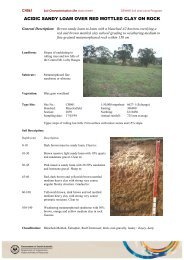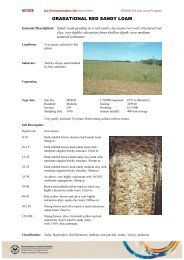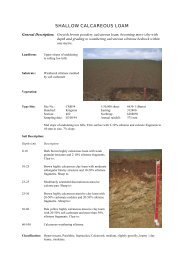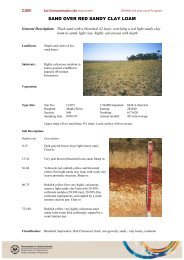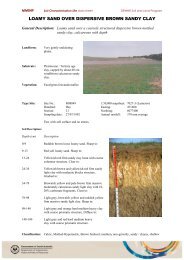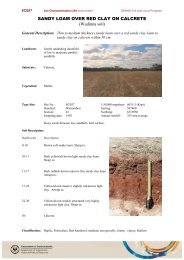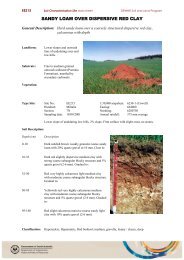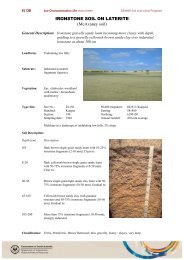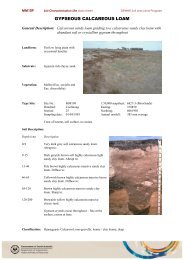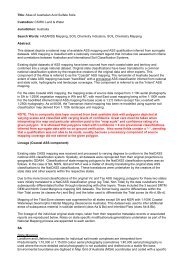Create successful ePaper yourself
Turn your PDF publications into a flip-book with our unique Google optimized e-Paper software.
Handbook (NCST 2009) will be familiar with this notion through the site concept. For example, attributesfor a landform element are observed over a circle (the site) of about 40 m diameter – the site in thisinstance defines the land-unit individual and its characteristic dimension. In contrast, landform patternattributes are observed over a circle of about 600 m diameter.Speight’s (1988, 2009) observations on the characteristic dimensions of landform elements and patternswere intended to provide a guide rather than a fixed value. The concept is far more valuable than this andwe use it here in conjunction with sets of defining attributes to construct the hierarchy of land-unit tracts.Table 3 shows the hierarchy of land-unit tracts. Each level in the hierarchy has a specified characteristicdimension along with a set of defining attributes measured at the accompanying scale. The characteristicdimension can be considered as the window size over which the defining attributes can be sensiblymeasured – different landscapes will have contrasting characteristic dimensions. For example, hillslopelengths may be very short (e.g. only a few metres in a strongly gullied landscape) or long (greater than akilometre in strongly weathered landscapes of low relief), so land facets of very different size result. Inmuch of Australia the mapped land-unit tracts are a finer resolution than the system and areaccommodated in the hierarchy as levels 5.1 and 5.2 with similar attribution to level 5.0. Likewise, landfacets can be subdivided. (e.g. Level 6.1).The characteristic dimensions in Table 3 have been changed from Speight’s (1988) original proposition toemphasize its role as a variable that defines both the appropriate measurement and the nature of thelandscape. The suggested values also better match the styles of survey undertaken across large areasduring the last 20 years.In Table 3, tracts are mapping units as opposed to taxonomic units. Note that polygon is often usedsynonymously with land-unit tract. Most land resource assessment in Australia is concerned with themapping and description of land-unit tracts at the land facet and land system level. Speight (1988) definesthese as follows:Land facet (Level 6): This is a land unit with attributes that include slope, aspect, topo-sequence position,microclimate, moisture regime, soil profile classes, land surface features, vegetation formation andvegetation community. Speight (1988) considers its characteristic dimension to be about 40 m but it canvary from 100 to just a few metres. Typically, these are unmapped. Note that the terms land componentand land element have often been equated with this definition of land facet.Land system (Level 5): This is a land unit with attributes that include relief, modal slope, stream pattern,toposequences, local climate, lithology, soil association, vegetation type or sequence, and proportionaloccurrence and arrangement of land facets. Speight (1988) considers its characteristic dimension to beabout 600 m, and he recommends this diameter for a land-system site.Note that these are definitions of conceptual land units. Explicit reference can be made to land-unitindividuals, types or tracts (e.g. land-facet individual, land-facet tract, land-facet type) but the context willusually convey the appropriate meaning. Particular mention should also be made of unique mapping areas– these are usually instances of land-system tracts that are later grouped into land-system types.To reiterate, the concept of scale in the hierarchy of land-unit tracts is based not on the cartographic scaleof mapping, but rather on:• the characteristic dimension• a set of defining attributes.If land facets and land systems are defined in terms of landform attributes alone, they are identical with thelandform elements and landform patterns defined by NCST (2009).Mapping land districts (Level 4) and land zones (Level 3) is usually achieved by grouping land systems.Mapping land units at higher levels can be achieved by grouping land districts but in reality, most mappingat the province (Level 1) and region (Level 2) level is undertaken using a divisive rather than an11




